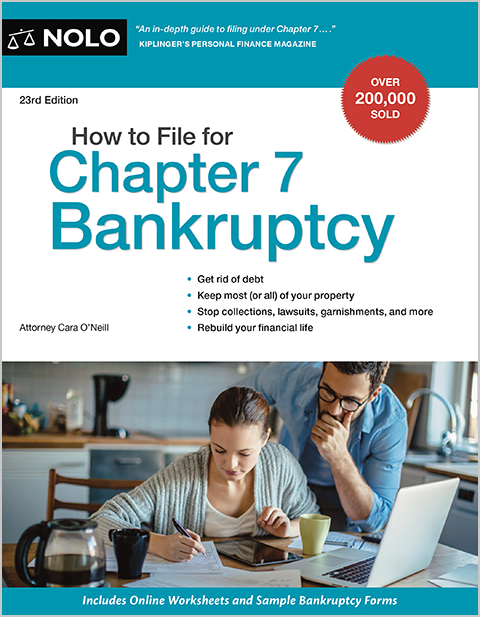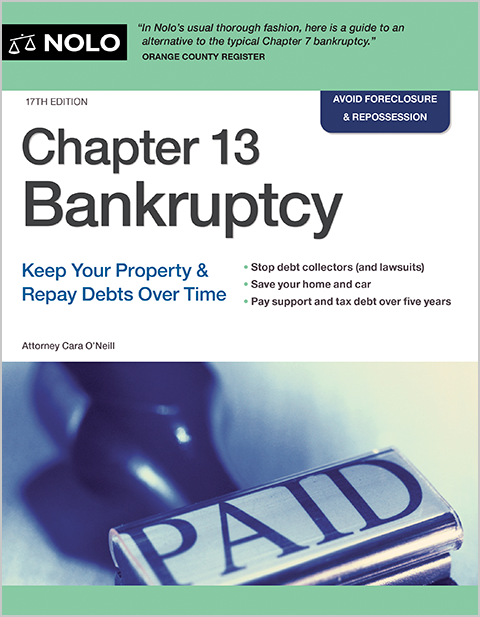Learn how to stop a Chapter 13 dismissal by opposing the trustee's motion to dismiss your Chapter 13 bankruptcy case.
Receiving a trustee's Chapter 13 motion to dismiss your bankruptcy case can cause havoc on your life, especially if you filed for Chapter 13 to prevent a home foreclosure, wage garnishment, or another collection action you don't want to resume. Such motions arise in Chapter 13 bankruptcy after the debtor falls behind on the monthly Chapter 13 repayment plan payments, and acting quickly by objecting to the trustee's motion is necessary to prevent a dismissal.
How Chapter 13 Works
One of the unique features of this chapter's payment plan is that it gives you time to catch up on past-due house and car payments and pay off nondischargeable taxes and support obligations while allowing you to repay only a portion of other debts, such as credit cards and medical bills.
Although Chapter 13 offers many benefits, it's notoriously difficult to complete. Why? The requirement to pay all "disposable income" to creditors through the plan leaves debtors with little money to address unexpected expenses and often jeopardizes the Chapter 13 case.
Responding to A Trustee's Motion to Dismiss Bankruptcy Chapter 13
The first thing you'll want to do after receiving a motion to dismiss is to read it carefully. The motion will tell you why the trustee is asking the court to dismiss your bankruptcy, and it will likely be for nonpayment. It will also explain when to file a response— usually within 21 days. It's important to respond within that time and ask for a hearing.
If the Trustee's Chapter 13 Motion to Dismiss is Wrong
In your response, you'll want to explain and provide proof of why the trustee is incorrect. For instance, if your employer took the plan payment out of your paycheck but the trustee didn't receive it, you would attach copies of your paycheck stubs showing the deduction. Or, if you mailed a check and the trustee cashed it, you'd attach a copy of the canceled check to your response.
If the Trustee's Chapter 13 Motion to Dismiss Is Correct
Explain how you intend to fix the problem. For instance, you might be behind on your payments because you changed jobs, and the new wage order did not start immediately. Or perhaps you didn't have the money to pay because you missed work due to an injury or illness.
If you have a compelling reason and can show that you can make the payments in the future, the trustee will usually work with you to reach an agreement that will let you stay in your Chapter 13 case. Most people negotiate an informal arrangement with the trustee before the trustee files the motion, usually shortly before or after the missed payment date.
If you didn't try to resolve the problem beforehand or the trustee refused to work with you, you'll have another opportunity at the hearing. Tell the judge why you need additional time and when you can catch up on payments and any accrued interest and fees. Don't forget to pay interest and fees because they can accumulate over the remaining years, leaving you with a large and unexpected unpaid balance at the end of your plan.
Also, you'll want to limit your request to no more than two months, less, if possible. The judge can't extend your plan period past five years, so lengthening your plan period won't be possible if you're in a five-year plan.
Options to Avoid a Chapter 13 Motion to Dismiss
Here are additional ways to handle Chapter 13 plan payment difficulties. These proactive options allow you to handle payment problems before facing a motion to dismiss.
Modify Your Chapter 13 Plan
If you can't afford your Chapter 13 payment because of a change in circumstances, you should contact your attorney. You might be able to modify your repayment plan and pay a lower monthly payment.
You'll have to file papers and provide documentation that proves the change in circumstances to stay in your case. Remember that plan rules require paying many bills in full, such as your mortgage payment, certain taxes, and support arrears. If your income drops to the extent that you can't make minimum mandatory payments, a modification won't be available.
Read Options if You Can't Make Your Chapter 13 Plan Payments for more information.
Ask for a Chapter 13 Hardship Discharge
Depending on how long you've been in your case, you might be able to ask the court for an early hardship discharge. You must be able to show several things, including that:
- you can't practically modify your plan
- the reason you can't pay is due to circumstances beyond your control, and
- you've paid the unsecured creditors (usually all creditors other than those holding your car or house note) what they would have received in a Chapter 7 case.
Your attorney must file a motion asking for the hardship discharge and provide proof to the court. Hardship discharges are relatively rare, but receiving one might be possible in limited circumstances.
Find out more by reading Getting a Chapter 13 Hardship Discharge.
Convert Your Case to Chapter 7 Bankruptcy
If you and your attorney decide you can't afford to make your plan payments, consider converting your case to Chapter 7 bankruptcy. However, it isn't always a great option, especially if you filed for Chapter 13 to avoid losing property or because you didn't qualify.
The rules vary in different jurisdictions, but you'll likely need to show that your income is low enough to qualify for Chapter 7 bankruptcy by passing the means test.
Also, you might lose "nonexempt assets" or the property you can't protect with a bankruptcy exemption to the Chapter 7 trustee. And if you're still behind on a house or car payment, you'll have to make arrangements with those creditors to keep those assets. Otherwise, you could face foreclosure or repossession.
Let the Court Dismiss Your Case
If you decide it's best to get out of the Chapter 13 case, you can do nothing. This approach can be appropriate if your financial situation has changed dramatically or if there are reasons that you can't convert to a Chapter 7 bankruptcy.
Usually, the court will dismiss the case without prejudice, allowing you to immediately file again. If the court thinks you abused the bankruptcy process or acted in bad faith, the court can dismiss your case with prejudice. You won't be able to file until the period spelled out in the dismissal order elapses.
Once dismissed, it's as if you never filed for bankruptcy. You'll lose the protection of the automatic stay—the order that prevented your creditors from trying to collect their debts from you while you were in your bankruptcy case. Your creditors can start garnishing your wages, attaching your bank accounts, and putting liens on your property.
Refile Your Case
If your case gets dismissed without prejudice, you can file again and start the Chapter 13 process over or file a Chapter 7 bankruptcy if you qualify. However, if you file within a year of the dismissal, the automatic stay will expire after 30 days, and your attorney will have to ask the court to extend it in the new case.
Learn about repeat bankruptcy filings and the automatic stay.

